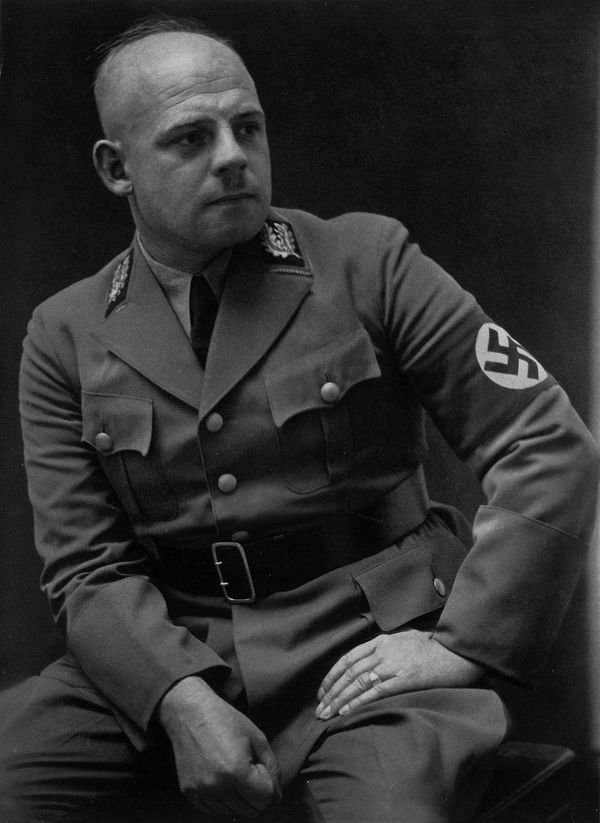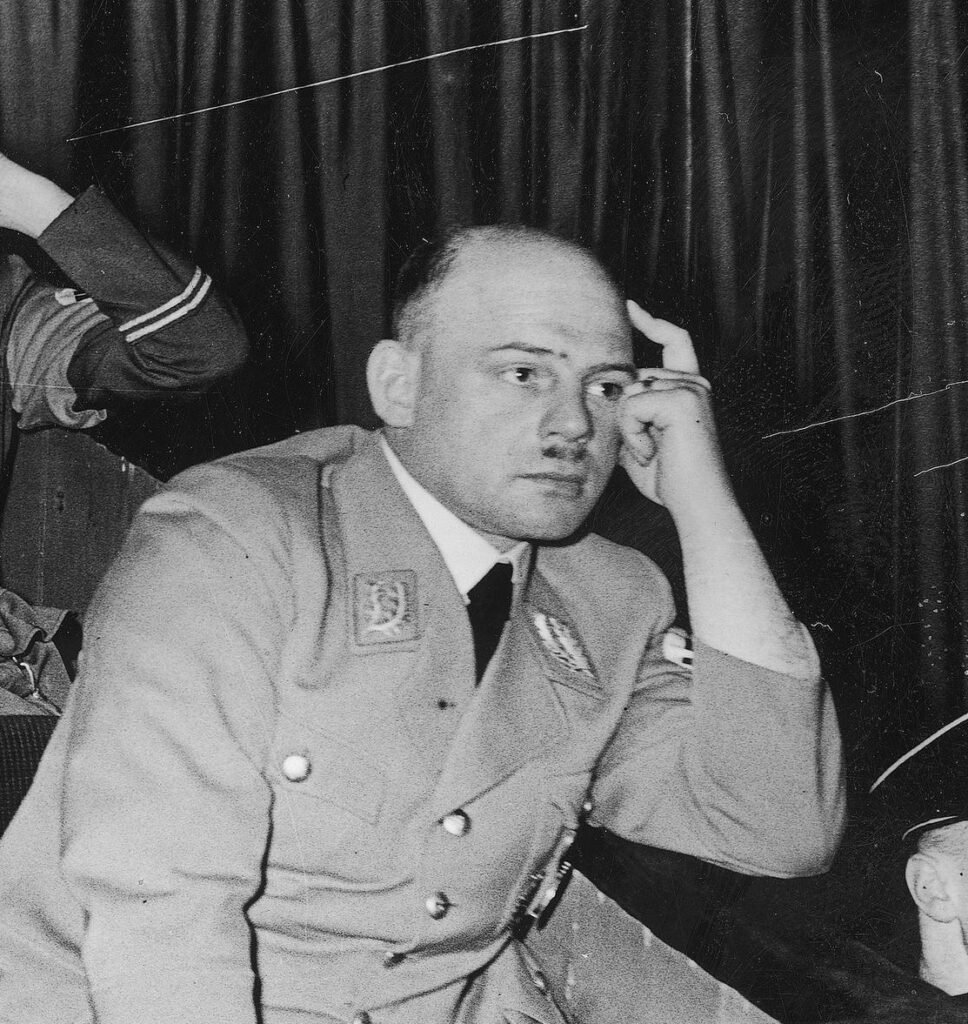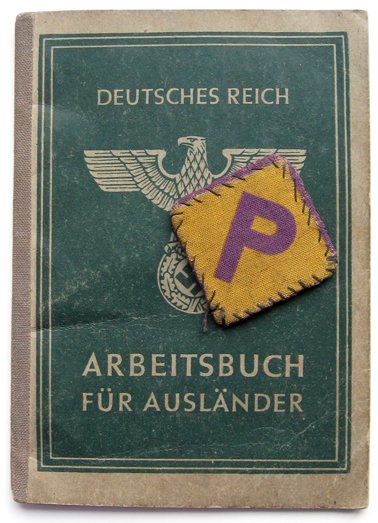Fritz Sauckel
Coming from pretty humble origins - being the only child of a postman and seamstress - it’s unlikely that Ernst Friedrich Christoph “Fritz” Sauckel, ever imagined, while a child, that he would grow up to be a slave owner. Presumably he never dreamt of such a thing during his adolescence, joining the Merchant Navy aged 15 in 1909 and sailing in Swedish, Norwegian and German ships. He became a first-class sailor - which shows he wasn’t afraid of hard work - rising to the rank of Able Seaman. It was Nazism that made him a slave owner and a criminal.
Born in Haßfurt (Kingdom of Bavaria), as the only child of a postman and a seamstress. Sauckel attended the local volksschule and the gymnasium in Schweinfurt, leaving in 1909 without graduating when his mother fell ill. He joined the merchant marine of Norway and Sweden when he was 15, first on a Norwegian three-masted schooner, and later on Swedish and German vessels. Starting off as a cabin boy, he went on to sail throughout the world, rising to the rank of Vollmatrose (able seaman). At the outbreak of World War I in 1914, he was on a German vessel en route to Australia when the vessel was captured by French naval forces. He was subsequently interned as an enemy alien in France from August 1914 until 20 October 1919. While interned, he studied mathematics, languages and economics.
When released, he returned to Germany and found factory work for the next few years in Schweinfurt as an apprentice locksmith and toolmaker in the Ersten Automatischen Gußstahlkugel-Fabrik & Cie ball-bearing works. In 1919 he joined the Deutschvölkischer Schutz- und Trutzbund , the largest and most influential anti-Semitic organization in Weimar Germany.
Early Life
The Deutschvölkischer Schutz- und Trutzbund (German Nationalist Protection and Defiance Federation) was the largest and the most active anti-Semitic federation in Germany after the First World War, and an organisation that formed a significant part of the völkisch movement during the Weimar Republic (1918-1933), whose democratic parliamentary system it unilaterally rejected. Its publishing arm issued books that greatly influenced the opinions of Nazi Party leaders such as Heinrich Himmler. After the organisation folded in around 1924, many of its members eventually joined the Nazis.
“The Bund fights for the moral rebirth of the German people.... It considers the pernicious and destructive influence of Jewry to be the main cause of the defeat and the removal of this influence to be necessary for the political and economic recovery of Germany, and for the salvation of German culture”.
Delegation of the NSDAP (Nazi Party) during the German Day organised by the Deutschvölkischer Schutz- und Trutzbund at Coburg, 1922. Click on the picture to go to the Coburg page.
Sauckel joined the Nazi Party (NSDAP) in January 1923 (member 1,395) and cofounded an Ortsgruppe (Local Group) in Ilmenau, serving as its Ortsgruppenführer. He also enrolled in the SA, the party’s paramilitary organization. He planned a “March on Berlin” with about 80 followers in conjunction with Adolf Hitler’s Beer Hall Putsch in Munich on 9 November 1923. However, he and 22 followers were arrested and briefly detained in Coburg before the march could get under way. Despite the forced dissolution of the party in the wake of the failed putsch, Sauckel remained active in political activities, establishing a right wing organization called Bund Teja, giving speeches, founding an SA front organization in Thuringia named Deutscher Wanderverein and serving as the Bezirksleiter (District Leader) for Thuringerwald.
In 1924 he married Elisabeth Wetzel, with whom he had ten children.
Following Hitler's appointment as Chancellor of Germany on 30 January 1933, Sauckel was appointed to the new position of Reichsstatthalter (Reich Governor) of Thuringia on 5 May 1933, a post he would retain until May 1945. The new post was created to provide more centralized control over the State governments. On 8 May he left the Thuringian cabinet and was succeeded by Willy Marschler. On 9 November 1933 Sauckel was promoted to SA-Gruppenführer and on 12 November he was elected to the Reichstag from electoral constituency 12 (Thuringia).
On 9 September 1934, Sauckel joined the SS as an SS-Gruppenführer at the invitation of Heinrich Himmler and was assigned to SS-Oberabschnitte Mitte (Senior Section Central) based in Weimar until 1 April 1936 when he was transferred to the staff of the Reichsführer-SS. Upon the death of Wilhelm Friedrich Loeper, Sauckel was appointed to succeed him as the acting Reichsstatthalter of both Anhalt and Brunswick from 30 November 1935 to 20 April 1937. On 23 January 1937 Sauckel was made the head of the Main Office for the Four Year Plan in Thuringia. He was also given an honorary rank of SA-Obergruppenführer on 9 November 1937.
Sauckel the Nazi
Sauckel in his Gauleiter uniform, 1937
Sacukel the Slave owner
On 21 March 1942, Sauckel was appointed to the position for which he would be forever linked in history, General Plenipotentiary for Labour Deployment (Generalbevollmächtigter für den Arbeitseinsatz) on the recommendation of Martin Bormann.
Sauckel worked directly under Reichsmarschall Hermann Göring within the Four Year Plan Office, obtaining and allocating labour for German industry and agriculture. On 27 March 1942, Göring issued a decree naming Sauckel the Leader of the Department of Labor Allocation within the Four Year Plan. In response to increased demands for labour from German war industries, Hitler issued a decree on 30 September 1942 granting Sauckel extraordinary powers over both civil and military authorities in the occupied territories. His agents were authorized “to issue directives to the competent military and civilian authorities” to ensure an adequate supply of labourers. Sauckel therefore met the ever-increasing requirement for manpower with people from the occupied territories. Voluntary numbers were insufficient and forced civilian labour was introduced within a few months. Of an estimated five million foreign workers brought to Germany, only around 200,000 came voluntarily, according to a March 1944 statement by Sauckel introduced as evidence at Nuremberg.
The majority of the acquired workers originated from the Eastern territories, especially in Poland and the Soviet Union where the methods used to gain workers were very harsh. The Army was used to pressgang local people and most were taken by force to the Reich. In addition to forced civilian labourers, Sauckel authorized the use of prisoners of war. Conditions of work were extremely poor and discipline severe, especially for concentration camp prisoners. All the latter were unpaid and provided with starvation rations, barely keeping those workers alive. Such slave labour was widely used in many German industries, including coal mining, steel making, and armaments manufacture. The use of forced and slave labour continually increased throughout the war, especially after Albert Speer, the Reichsminister of Armaments and War Production, in April 1942 brought about the formation of the Central Planning Board, which determined the labor requirements of industry, agriculture and all other components of the German war economy, and requisitioned that labor through Sauckel’s office. It has been estimated that over 12 million such laborers eventually were brought forcibly to Germany to work, often by brutal coercion
Identity document issued to a Polish forced labourer in 1942, together with a letter "P" patch that Poles were required to wear.
Polish citizens being rounded up to work for thee Reich
‘They Are Catching Humans as Dogcatchers Used to Catch Dogs’
Of the 12 million people taken to Germany during World War II, as admitted by Sauckel, only 200,000 were volunteers, and the rest were simply caught and brought to the Reich by force. The number of volunteers in the occupied territories was very small, and after Stalingrad, there were none at all. Therefore, on the orders of Sauckel, the Nazis rounded up people right on the streets.
The transfer and enslavement of Soviet citizens had reached unprecedented levels; Thomas Dodd of the American prosecution noted at the Nuremberg trials: “On the 5 October 1942, for example, the Defendant Sauckel wrote to the Defendant Rosenberg, stating that 2 million foreign labourers were required and that the majority of these would have to be drafted from the recently occupied Eastern territories and especially from the Ukraine.
“Sauckel's office sent out circulars to captured towns and villages with quotas for transporting people to the Third Reich. Local collaborators drew up lists. Mass raids were then carried out. At times entire families were rounded up; relations were separated from one another to different parts of Germany. People were put into freight wagons like cattle, regardless of the weather, and taken to the Reich.”
On 27 October 1944 he was given a cash award of 250,000 Reichsmarks in honor of his 50th birthday and for his contributions to the Reich. On 10 April 1945, only a day after declaring Weimar a fortress city and exhorting his Volkssturm forces to resist the approaching American Army, Sauckel fled the city by car. After the end of the war, he was arrested in Salzburg by members of the US Army Counterintelligence Corps on 12 May 1945. He was interned in the 7th Army Interrogation Center in Augsburg, Camp King in Oberursel and, finally, in Nuremberg.
Nuremberg
On 20 November 1945, Sauckel was put on trial before the International Military Tribunal as a major war criminal. He was indicted on all four charges of conspiracy to commit crimes against peace; planning, initiating and waging wars of aggression; war crimes and crimes against humanity. He defended the Arbeitseinsatz as "nothing to do with exploitation. It is an economic process for supplying labour". He denied that it was slave labour or that it was common to deliberately work people to death (extermination by labour) or to mistreat them. Yet, documents put into evidence showed that he was complicit in exploiting the labourers:
All the men [prisoners of war and foreign civilian workers] must be fed, sheltered, and treated in such a way as to exploit them to the highest possible extent at the lowest conceivable degree of expenditure.
— Letter from Fritz Sauckel to Alfred Rosenberg, 20 April 1942, Report on Labor Mobilization Program[19]
Sauckel was found guilty of war crimes and crimes against humanity, and was hanged at Nuremberg Prison on 16 October 1946, 11 days before his 52nd birthday after receiving Communion. His last words were recorded as "Ich sterbe unschuldig, mein Urteil ist ungerecht. Gott beschütze Deutschland. Möge es leben und eines Tages wieder groß werden. Gott beschütze meine Familie."
"I die an innocent man, my sentence is unjust. God protect Germany. May it live and one day become great again. God protect my family."
Albert Speer, Nazi munitions minister, and Fritz Sauckel, who provided slave labor during the Nazi regime, eat lunch from army mess kits in the Palace of Justice in Nuremberg, where they are on trial for war crimes.
Sauckel in his cell at Nuremberg
Watch my Video biography
Sauckel giving evidence at Nuremberg







